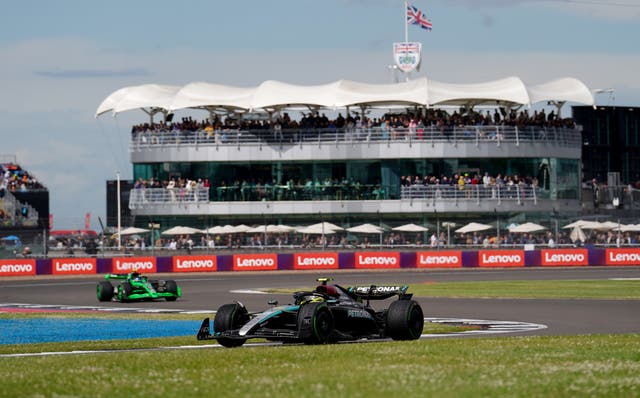‘No silver bullet’ for decarbonising Formula One, ESG boss says
With no plans to reduce the number of races worldwide, Ellen Jones said F1 is delivering emissions cuts through a number of solutions and innovations.

There is “no silver bullet” to decarbonising Formula One, its head of environment, social and governance (ESG) has said as she outlined how the championship is driving innovation to cut its carbon and material footprint.
Ellen Jones, who joined the motorsports giant as its first head of sustainability in 2022, said it is uniquely placed as a green transition leader thanks to its “fantastic global audience” and “the innovation that comes from teams”.
F1 has committed to reaching net zero by 2030 and plans to deliver this by cutting 50% of its emissions, compared with its 2018 baseline year, before offsetting the rest through carbon credits.
It is no small challenge given the footprint of 10 teams, thousands of workers, tonnes of equipment and high-performance hybrid cars travelling across the world for 24 weeks of the year.
The championship reported its carbon footprint as a hefty 256,551 CO2 equivalent tonnes in 2018, and said it reduced this by 13% during the 2022 season.

The cars themselves account for just 0.7% of its emissions with the biggest impact coming from road, air and sea logistics (45.0%) and travel for the teams and employees (27.7%).
Recent years have seen a growing sustainability debate over whether F1 should cut down the number of events it holds after increasing the races from 16 in the 1980s-90s to a record 24 last year.
But Ms Jones said the championship “is really at the size it wants to be at right now”.
Instead, she said the sustainability focus is to show that “you can grow well” and that it’s possible to make a material reduction to carbon footprints without reducing size.
“We never say there’s one silver bullet,” she said. “Of course, you can do massive contraction, and the world saw that in Covid, in terms of the change in activity that people did.
“We also saw post-Covid how those emissions went straight back up from a global perspective, as people opened their doors again.
“So what we’re really focused on is: What are the solutions and the steps we take to drive (down) carbon emissions, rather than the principle of saying there’s a one-solution-to-fit-all.”
F1 has made recent efforts to rearrange the calendar to reduce freight distance travelled, moving Japan to April to align closer with China, and Qatar running back-to-back with Abu Dhabi.
On whether F1 might consider hold races closer together in one region at a time to reduce impact, it is understood there is no potential for midweek races.
Ms Jones said: “Calendar is another area where we’re always looking to make progress. You’ve seen that in ’24 and ’25 but we know that there is more to do, and we’ll continue to have those conversations as we work to manage it effectively.”
With the number of races as a non-negotiable, F1’s decarbonisation strategy instead looks to a multitude of solutions, such as investing in alternative fuels, working with event promoters to switch towards renewable energy, adapting transport methods and, eventually, carbon credits.
Offsetting emissions is considered an essential tool for tackling hard-to-debate emissions but remains controversial because of concerns around the viability of an effective scaled-up market and fears polluters may use credits in place of efforts to reduce emissions at source.

Ms Jones said F1’s plan is to cut emissions as much as possible “first and foremost”, adding that her personal goal is to exceed the current 50% ambition before they turn to offsets.
F1 is “absolutely watching” the market and the latest science on offsets but added that it is still “quite immature”.
“When we have made our reductions, (we) will make an informed decision on what is the science of the day,” she said.
Elsewhere, a major challenge has been shifting a decades-old culture of competitive rivals working in siloes, towards collaboration.
The championship is not a hierarchy where decisions are made at the top and cascaded down through the organisation but a web of relationships between stakeholders.
“When I first stepped in, (I) was just like whoa, wait a minute, people don’t even want to talk to each other,” she said.
“From my perspective, it’s really about how we bring all the stakeholders to the table, because Formula One’s sustainability strategy isn’t just about the four walls of Formula One management.
“We won’t succeed unless we have our teams, our partners, our logistic providers, all pulling and delivering with us.”
After developing the strategy, part of Ms Jones’s role is to work with every individual stakeholder group to draw up their delivery plans.
When a solution is developed the teams “race to get it out the fastest”, she laughed, calling that level of competition “fantastic” and adding that next comes teams sharing the best ideas and pushing boundaries further.
“That’s the kind of brilliance of F1, that it’s not about saying we’ve got the perfect solution, because there is no definition of perfect. What is leading today is table stakes tomorrow.”
“And even further out, by sharing best practice, we want people to say ‘ah, if Formula One can do this, we can do this’.”





